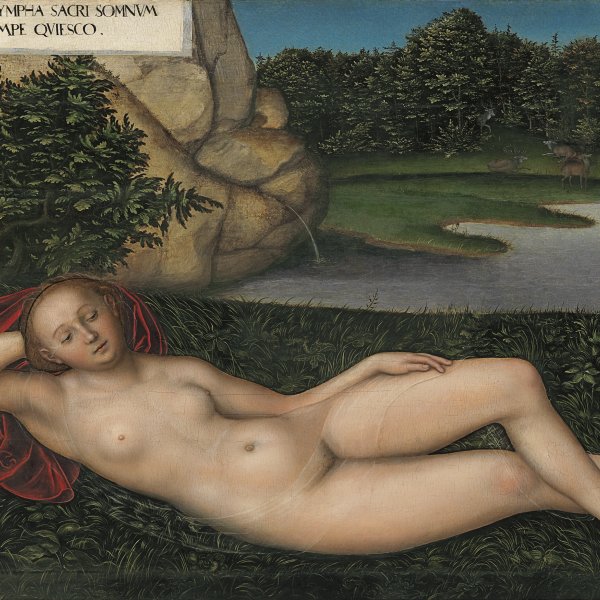The Virgin and Child with a Bunch of Grapes
Together with Albrecht Dürer, Lucas Cranach the Elder was one of the leading figures in the 16th-century German art world. He took the name of his native city of Kronach, where he trained in the family workshop. Cranach worked for the Emperor Maximilian and travelled to the Low Countries, consequently adopting a less linear, softer style for his figures. He produced portraits, religious compositions and prints and was associated with the ideology of the Reformation, although also working for Catholic clients. He moved to various German and Austrian cities in order to execute commissions for his most important patrons, including Vienna, Wittenberg, Augsburg, Innsbruck and finally Weimar, where he died. In this work the artist depicts the Virgin in the foreground, using a delicate sfumato derived from Italian art. Cranach’s most characteristic style, however, cannot be described as Italian, and he developed the classic female prototype within German Renaissance art. In the present painting the Christ Child, seated on Mary’s lap, has a surprisingly unattractive face. The grape, which he takes from the bunch that his mother holds, refers to the Eucharist and to his role as Redeemer. Cranach depicts a forest in the background with a fortress on the right and a path leading up to it with a figure that has been identified as Saint Joseph. The fortress and the pine tree on the left are recurring elements in Cranach’s religious compositions. This panel is notable for the exquisitely detailed treatment of the landscape, which contrasts with the monumental figure style. Painted in oil, it is signed on the low wall behind the Virgin with Cranach’s usual symbol of the winged serpent.
With regard to his treatment of the nude and the human form Cranach’s ideal of female beauty, fully expressed in his mythological compositions of Venuses and nymphs, had little to do with the classical norms prevailing in Italy. His female types are expressive and elegantly sensual with a certain note of eroticism, creating a non-Italian effect. In addition, he repeated his figure types throughout his career, creating a distinctive model that characterised his style and oeuvre.
Cranach’s religious paintings were extremely well received in his day. This was undoubtedly due in part to certain characteristic features that are to be found in this Virgin and Child, which is generally dated to the first decade of the 16th century. The Virgin’s face, which is softly outlined and modelled, recalls Leonardo’s technique of sfumato. Such features, which made Cranach’s figures particularly sweet and gentle, are to be found in his work of around 1509 and 1510 following a trip to the Low Countries during which he may have had the chance to study Italian art at the court of Margaret of Austria. In addition, a similar approach to volume is to be found in two important works of this period: Salome, in the Bayerisches Nationalmuseum in Kronach, and Venus and Cupid in The Hermitage, St. Petersburg. The present panel has been compared to those two works with regard to its date. Despite the softness evident in the two figures, whose heads are crowned with delicate, almost invisible, glowing haloes, the face of the Infant Christ is less pleasing with regard to its features and handling than Mary’s beautiful, rounded countenance.
The present panel has a landscape background, an element that was always crucial in Cranach’s compositions from the outset of his career and which contained elements that would subsequently be developed by the Danube School artists. This landscape, depicted from a high viewpoint, is organized around a large expanse of woodland that terminates in a chain of mountains painted in striking tones of blue, which leads the eye into the distance. The fortress on the top of the mountain on the right and the pine tree on the left are recurring motifs in Cranach’s compositions and are to be found in his Virgin and Child groups of around 1518. Lübbeke drew attention to the particular treatment that the artist gave to both the figures and the landscape in the present panel. In the landscape Cranach included the most minute details on a tiny scale such as the delicate branches of the trees, the shrubs and the fortress on the right. We can also make out a tiny figure who has been identified as Saint Joseph climbing up the steep path to the fortress. The precision in the depiction of the background contrasts with the brushwork and sense of monumentality of the foreground, occupied by the two figures. They are imbued with a sense of melancholy which is expressed in the Virgin’s gaze and in the Infant Christ’s self-absorption.
The fact that the composition includes a bunch of grapes held by the Virgin and which the Christ Child is eating has suggested a reference to the Eucharist and to Christ’s future role as Redeemer. The panel is signed with the winged serpent on the ledge on the left. Cranach derived this element from the coat-of-arms granted to him by the Elector of Saxony in 1508. On the death of his son Hans the artist modified the wings.
The panel was in the collection of Langton Douglas in Great Britain then in the Ederhiemer and Schniewind collections in New York. It was acquired for the Thyssen-Bornemisza collection in 1936 and appeared in the catalogues of the Collection from 1937.
Mar Borobia










